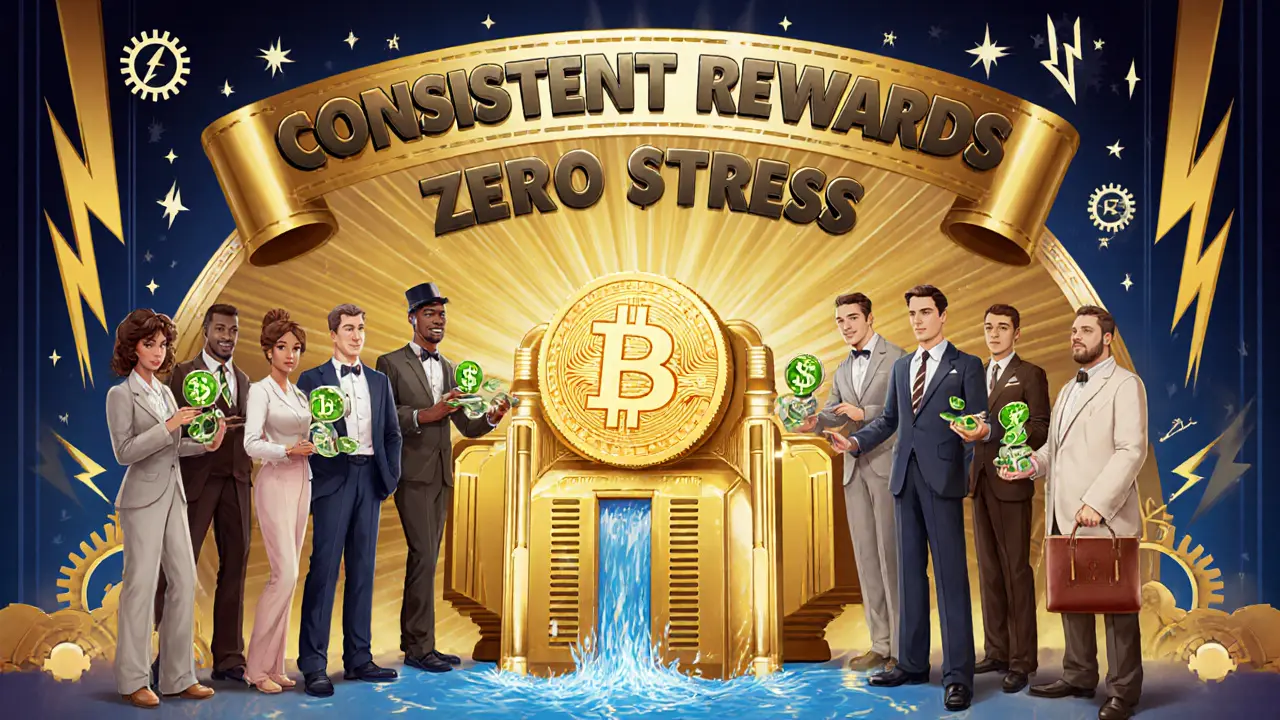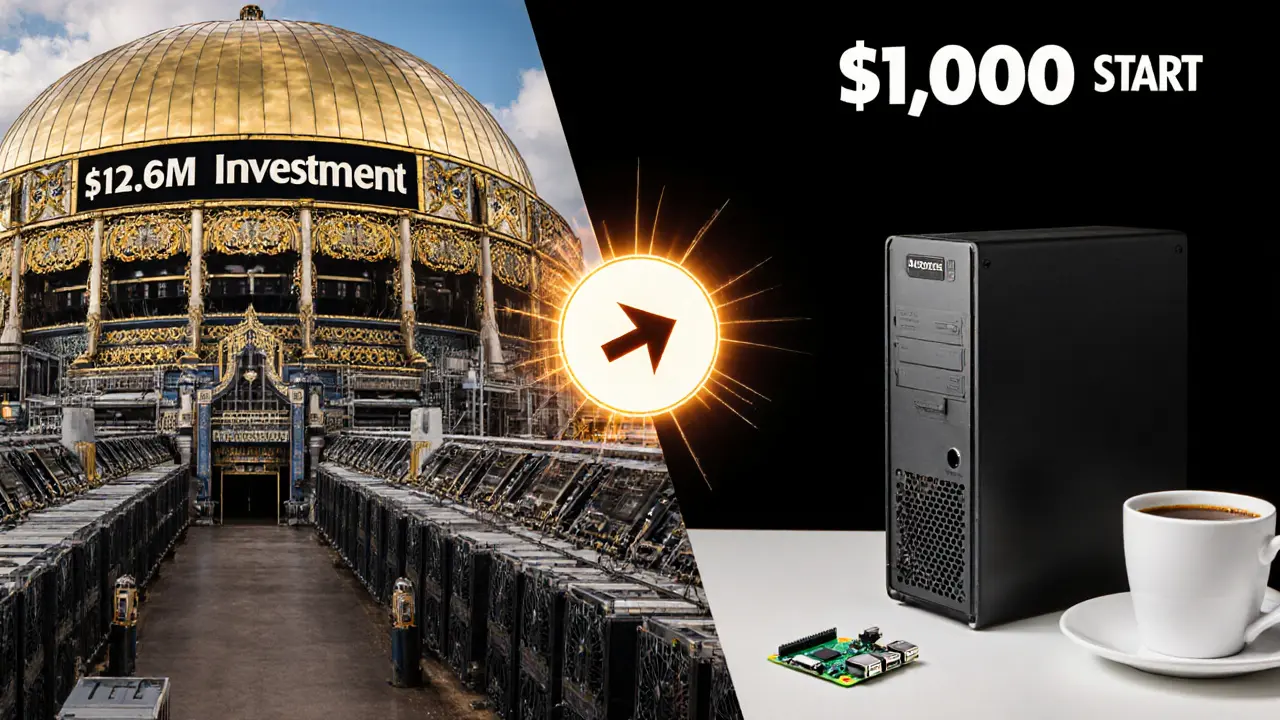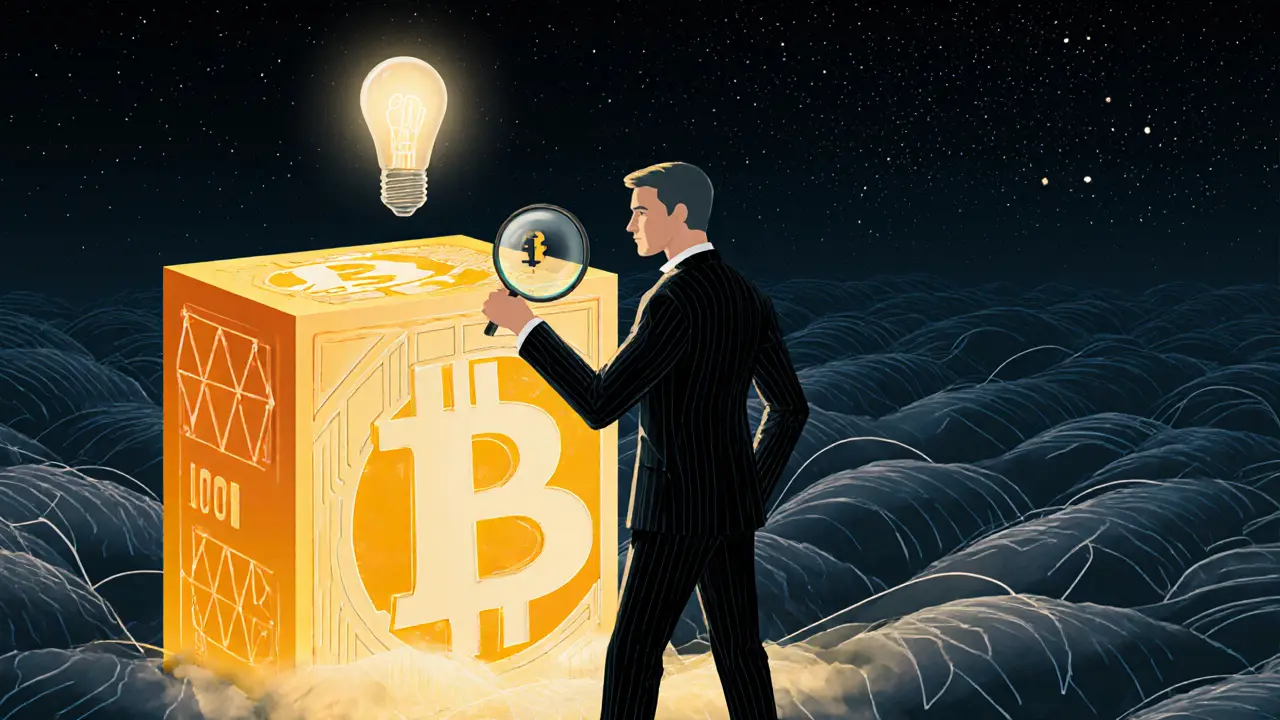Mining Calculator: Solo vs Pool Earnings
Estimate Your Mining Earnings
See how your mining setup compares for both solo and pool mining options
Results
Enter your mining parameters above to see results
Important: Bitcoin mining is highly competitive. Solo mining has extremely low odds of earning a block reward (see article for details). Pool mining provides consistent daily income but requires sharing rewards.
When you start mining Bitcoin, the first big decision isn’t about which ASIC to buy-it’s whether to go it alone or join a group. Solo mining means you’re the only one solving the math problems. Pool mining means you team up with hundreds or thousands of others. One offers the dream of a full block reward. The other gives you a steady paycheck. But which one actually makes sense in 2025?
What Solo Mining Really Means
Solo mining is exactly what it sounds like: you run your own hardware, connect directly to the Bitcoin network, and try to find a block by yourself. No middlemen. No sharing. If you win, you get the whole 3.125 BTC plus transaction fees. That’s over $200,000 at current prices. But here’s the catch: you have to actually find that block first. As of late 2025, the Bitcoin network hash rate is over 700 EH/s. That’s 700 quintillion calculations per second. For a single miner with a typical 100 TH/s rig, the odds of finding a block are roughly 1 in 5.7 years. That’s not a guess. That’s math. Even with a 1 PH/s setup-equivalent to about 30 Antminer S21 units-you’re looking at an average wait of 18 months just to see one block reward. Most solo miners aren’t hobbyists. They’re institutional operators with multi-megawatt farms. Foundry USA, for example, controls over 13% of the network’s hash power. They mine solo because they can afford the risk. They have the power, the cooling, the uptime, and the capital to weather long dry spells. For everyone else? It’s a financial gamble with no payout in sight. One Reddit user ran 200 TH/s for 14 months and found zero blocks. He switched to a pool and started earning $5 a day. That’s not luck. That’s probability.How Pool Mining Works (And Why It’s So Popular)
Pool mining is like buying lottery tickets as a group. Everyone chips in their hash power. When the group wins, the prize is split based on how much work each person contributed. You don’t need to be a tech wizard to join. Most pools-like Slush Pool, F2Pool, or AntPool-have simple web dashboards. Plug in your miner’s IP, enter your wallet address, and you’re done. Setup takes under 15 minutes. No full node. No config files. No syncing the entire blockchain. In return for convenience, you pay a fee. Most pools charge between 0.5% and 3%. F2Pool uses a PPLNS model (Pay Per Last N Shares), which smooths out rewards over time. Slush Pool sticks with a flat 2% fee. That’s it. The payout? Consistent. A 100 TH/s miner in a pool earns about $12-$15 per day after fees. That’s enough to cover electricity in most regions. No waiting. No stress. Just daily deposits into your wallet. And that’s why 87% of miners with under $50,000 in equipment choose pools. It’s not about being lazy. It’s about survival.Hardware Requirements: Solo vs Pool
The hardware you need is where the two paths split wide open. For solo mining, you need serious power. To have even a 50% chance of finding a block in a year, you need to control about 0.6 EH/s-that’s 600,000 GH/s. That’s roughly 1,800 Antminer S21 units. At $7,000 per unit? You’re looking at $12.6 million in equipment alone. Add electricity, cooling, space, and maintenance, and you’re spending over $2 million a year just to stay alive. For pool mining, you can start with one Antminer S19. That’s $4,000. You plug it in. You connect to a pool. You start earning. You don’t even need a dedicated server. A Raspberry Pi can handle the pool connection. Even GPU miners can join pools for altcoins like Ravencoin or Ergo. You don’t need ASICs to mine profitably in a pool. But you absolutely need them to even dream of solo mining Bitcoin.
Costs, Fees, and Hidden Risks
Pool mining sounds too good to be true? It’s not. But it has downsides. First, you’re trusting the pool operator. In 2014, the Eligius pool went offline for days. Miners lost income. In 2023, ViaBTC raised fees without warning. Some users lost 40% of their daily earnings overnight. Second, you don’t control your own node. You’re dependent on the pool’s infrastructure. If their servers crash, your shares stop counting. Some pools have 99.9% uptime. Others? Not so much. Solo mining has its own risks. You need 99.9% uptime on your hardware and internet. One power outage? You lose your chance at that block. One network glitch? Your node desyncs. You miss rewards. And if you’re not running a full node, you’re not even truly solo mining-you’re just mining on a third-party node, which defeats the whole point. Then there’s the emotional cost. Waiting months-or years-for a reward is psychologically brutal. Most people can’t handle it. They quit. They switch. And they never go back.Who Should Mine Solo?
The answer is simple: almost no one. If you have less than 1 EH/s, solo mining is a fantasy. You’re not a miner-you’re a lottery ticket buyer. And the odds are worse than Powerball. The only people who should mine solo are:- Large mining farms with over 1 EH/s hash rate
- Operators who own their own power plants or have access to near-zero-cost electricity
- Those who believe deeply in Bitcoin decentralization and want to avoid pool centralization
- People with deep technical skills and zero tolerance for third-party dependency

Who Should Mine in a Pool?
If you’re reading this, you’re probably in this group. Pool mining is for:- Beginners who want to learn without risking their savings
- People with under $50,000 in mining equipment
- Anyone who needs consistent income to cover electricity bills
- Miners using GPUs for altcoins
- Anyone who doesn’t want to manage servers, nodes, or uptime
The Future: Will Solo Mining Ever Come Back?
Some say transaction fees will save solo mining. When block rewards drop to 1.56 BTC in 2028, fees might make up the difference. But that’s a long shot. Even then, you’d still need massive hash power to compete. Others point to new ASICs like the Antminer S25, which delivers 400 TH/s at 14 J/TH. That’s more efficient. But efficiency doesn’t fix the math. The network difficulty keeps rising. Every two weeks, it adjusts upward. The bar gets higher. The odds get worse. CoinBureau predicts that by 2025, pool mining will account for 92% of individual miner participation. That’s not a trend. That’s a law of economics. Solo mining won’t disappear. But it will become a niche for institutions, not individuals.Final Decision: What Should You Do?
Ask yourself these questions:- Do you have over $1 million in mining equipment?
- Do you have access to electricity under $0.03/kWh?
- Can you handle months or years without income?
- Do you enjoy configuring Linux servers and debugging node sync errors?
Is solo mining worth it for beginners?
No. Solo mining requires massive hash power, technical expertise, and the ability to go months without income. Beginners should start with a pool to learn the basics, cover electricity costs, and avoid financial burnout.
How much money do you need to start solo mining?
To have a realistic shot at mining a Bitcoin block within a year, you need at least 1 EH/s of hash power. That’s roughly $12 million in Antminer S21 units, plus $1.5 million annually in electricity and cooling. Most individuals don’t have this capital.
Do pool mining fees eat into profits?
Yes, but not significantly. Most pools charge 0.5%-3%. For a 100 TH/s miner, that’s about $0.50-$1.50 per day on a $12-$15 payout. That’s a small price for consistent income and zero risk of long dry spells.
Can I mine Ethereum solo now?
No. Ethereum switched to proof-of-stake in 2022. Solo mining only applies to proof-of-work coins like Bitcoin, Litecoin, and some altcoins like Ravencoin. You cannot mine Ethereum with ASICs or GPUs anymore.
What’s the best pool for Bitcoin mining?
Slush Pool is the oldest and most reliable, with 24/7 support and a 2% fee. F2Pool offers lower effective fees with its PPLNS model and high uptime. AntPool and Foundry USA are good for larger miners. Choose based on location, fee structure, and payout frequency.
How often do pool miners get paid?
Most pools pay daily or when you reach a minimum threshold (like 0.001 BTC). Some, like Slush Pool, pay daily regardless of balance. Others wait until you hit a higher amount. Check your pool’s payout settings.
Can I switch from solo to pool mining later?
Yes. Many miners start solo, realize the financial strain, and switch to a pool within months. There’s no penalty. Your hardware works the same. Just disconnect from your solo node and connect to a pool’s server.
Does pool mining make Bitcoin less decentralized?
It can, if a few pools control too much hash power. But the network has safeguards: miners can switch pools instantly. If a pool gets too big, miners leave. That’s why no single pool has ever held more than 25% of Bitcoin’s hash rate. Decentralization is maintained by choice, not structure.



